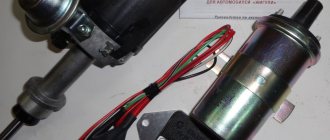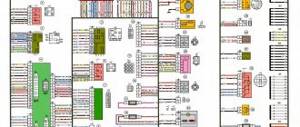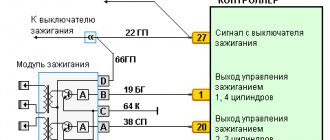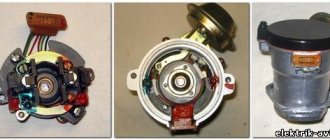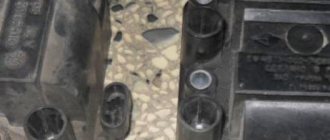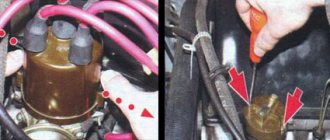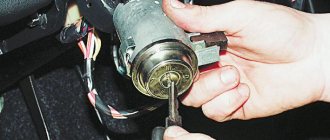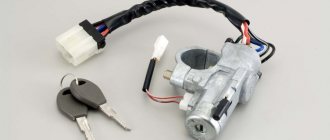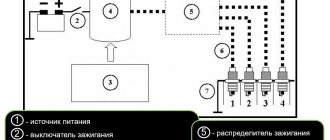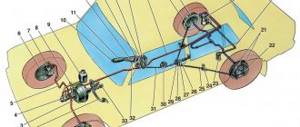Failure of the contact ignition system
What indicates problems with the contact ignition system of an internal combustion engine?
With reasonable use, the contact ignition system will not cause any trouble and will last a long time without reminding you of itself. In order for the system to work without failures, it is necessary to be able to diagnose certain malfunctions.
- No spark. Such a malfunction in the system can occur when wires break, contacts burn, the ignition coil malfunctions, or a spark plug breaks.
- The engine malfunctions or does not reach full power when running. This scenario is possible when the contacts are loose, there is a breakdown in the rotor, or the spark plug is faulty.
To eliminate or prevent such breakdowns, it is necessary first of all to monitor the cleanliness and integrity of the contacts and fastening of the wires. If one or another part fails, it must be replaced.
The engine may malfunction due to uneven firing of the spark plugs. The electrodes of the spark plugs can often burn out, causing malfunctions. You can clean the electrodes at home. To do this, they need to be cleaned with a file, and if the electrodes are badly burned, the spark plug will have to be replaced. The condition of the spark plug is indicated by the color of the electrodes. In a working spark plug it is light brown; in a faulty spark plug the electrodes are burnt black.
Another problematic component of the system is high-voltage wires . Often they “move away” from the electrodes, as a result of which contact is lost and the engine does not start. In addition, a situation often arises when, instead of igniting the air-fuel mixture, the current goes “to the side”. To solve problems with wires, it is recommended to purchase silicone wires through which current does not flow.
A simple recommendation is not to climb under the hood of your car during rain or heavy snow, and also do not drive through deep puddles. If water gets under the hood, electrical parts of the vehicle's control systems may be flooded. Electronic parts that get wet will not work. Therefore, the car may stall, and the driver will be able to continue the journey only when all the parts are dry.
We recommend: Real vehicle ground clearance
Adjusting the BSZ on a VAZ
The adjustment process is carried out on a warm internal combustion engine. There are two types of adjustment of the ignition system: using a special strobe light and by ear.
A stroboscope is a special device with a lamp that blinks when it receives signals from the IAC. To make the adjustment, you need to connect the power of the device to the battery, and the second wire is connected to the cable of the first spark plug. Then you should slightly loosen the nut securing the distributor, and the blinking lamp should be brought to the pulley. Next, the distributor body should be carefully rotated until the mark on the pulley is positioned opposite the short mark. Having completed this, the fastening nut can be tightened.
Regarding the method of adjusting by ear, here you need to do several sequential steps. The engine is started, then the distributor fastening nut is loosened. The distributor is rotated (within 15 degrees) until the operation of the internal combustion engine is optimal and stable. When such a torque is detected, the nut is tightened back.
There is also another method of adjustment without the need for a device. While driving, you need to reach a speed of 40 km/h and when the engine warms up to a temperature of 80-90 degrees, you should engage 4th gear and depress the gas pedal. If the BSZ is set correctly, then a short-term detonation will occur, and then the internal combustion engine will begin to gain speed. If at this moment a clear detonation sound is heard, then you will need to turn the distributor clockwise, approximately one degree. This operation should be performed until the knocking stops. When a dip in speed is detected, then it is necessary to turn the distributor counterclockwise.
Although progress has stepped far forward, there are still many adherents of the classic VAZ models. Such cars include the old kopeck, which has long been discontinued, and the more modern, but also no longer produced, models 2104 -. In this article we will talk about how contact ignition changes to contactless (electronic) and whether there is really any benefit from such a replacement.
Why is replacement needed?
On the Internet in various automotive forums, owners conduct multi-page debates about the advantages of contactless ignition
. And these advantages are really enough. After installing contactless ignition, operation becomes smooth and soft. There are no dips when the car accelerates sharply. Starting is significantly easier, especially in cold weather. And of course, noticeable fuel savings.
The device and principle of operation of contactless ignition.
Essentially a contactless ignition
not much different from the
contact ignition
. The only differences are the absence of a distributor and the presence of a pulse sensor with a transistor switch unit.
Installation of a contactless ignition system on a VAZ
First you need to purchase a contactless ignition
For . We strongly recommend purchasing contactless ignition from trusted retail outlets. It is worth paying attention that the kit must correspond to the characteristics of the engine of your car, and the length of the distributor shaft should not differ from the length of the shaft that is currently installed on the unit.
The contactless ignition kit should include:
- distributor
- coil
- switching unit
- connecting wires
- set of high voltage wires
- four spark plugs marked DVRM
To replace a contactless ignition system
passed successfully, you need to follow the correct sequence of work.
First you need to remove the negative one. Then we disconnect the wires from the ignition coil and the central high-voltage wire, after which we remove the distributor cover. Now we set the slider to the position as shown in the figure so as not to change the ignition settings. You also need to make a mark on the block in order to correctly align the new contactless ignition distributor. Please note that we place the mark in the middle of the five slots on the bottom of the distributor body. Now you can unscrew the nut and remove the old distributor of the contact ignition system
.
Before installing contactless ignition, open the cover of the new distributor and place the slider in the same position as on the old one, perpendicular to the engine. And only then we insert it into the holes of the cylinder block. Then we align the mark that we made previously and tighten the body with a nut.
Then we assemble: put on the cover, connect the high-voltage wires.
Then we disconnect and remove the old ignition coil and put a new one in its place. We connect the other end of the central high-voltage wire to it, but now we won’t need the brown wire that went from the coil to the distributor and can safely put it aside.
We connect all the high-voltage wires in their places. We connect two brown wires to the new ignition coil to contact “K”, and two blue ones to contact “B”.
Now we decide on a place for the switch (possibly in the area of the washer reservoir) and secure it using self-tapping screws. We connect the connector and twist all the wires with electrical tape.
After the completed operations, start the engine and, if necessary, adjust the operation of the contactless ignition.
Good day, all car enthusiasts! Friends, you know better than anyone else that literally every driver, day and night, strives to improve his own vehicle. Absolutely any component of the car can undergo tuning, from the trunk lid, on which we so love to mount the ever-popular spoiler, to the engine, whose power is increased in a variety of ways. Today, we will look at neither one nor the other under a microscope - contactless ignition. We will learn the principle of its operation, its structure, possible malfunctions, and in the end, friends, you will receive a master class on installing the mechanism from your humble servant.
The “lion's share” of those present here certainly wondered, “What kind of tuning is this? This is the system I have, integrated into the standard kit.”
I’ll say right away that this publication will be of little use to owners of new modern cars, because a contactless ignition system is installed in absolutely every such model, regardless of the manufacturer’s brand. So, I will say more for the owners of some old foreign cars, as well as native domestic classics. If you are already quite tired of hearing about the various advantages of BSZ and “drooling,” it’s time to purchase the installation. Do you doubt whether it is relevant? Let's think together...
Principle of operation
The high-voltage pulse generator is an ignition coil, which operates on the principle of a step-up transformer. It is connected to the breaker contacts. When its contacts are closed, current flows through the primary coil, creating a magnetic field, the lines of force of which penetrate the secondary winding.
After opening the contacts, the magnetic field disappears, which leads to the appearance of an induction current in the secondary winding equal to 16 -18 kV. At this moment, a self-induction current of approximately 300 V is formed in the primary coil, directed in the opposite direction from the interrupted current.
What does secondary voltage depend on?
The presence and strength of the secondary voltage depends on the strength and rate of decrease in the self-induction current in the primary winding. It is the current arising in the primary circuit of the coil that causes sparking and burning of the breaker contacts. To reduce this effect, a capacitor is connected parallel to the contact, which is charged at the moment the contacts break and discharges when a self-induction current appears, accelerating the process of its decay.
The capacitor is selected for the ignition system individually for each engine type. Its capacitance is usually in the range of 0.17 - 0.35 µF and any deviation leads to a decrease in the secondary voltage.
To ignite the working mixture, a secondary voltage of 8 - 12 kV is sufficient. Since there are losses during the distribution of high voltage and when it flows through wires and spark plugs, for reliable operation of the system the secondary voltage must be 16 - 25 kV. In addition, the increased voltage necessary to ignite a lean mixture in the event of a fuel system malfunction.
The secondary voltage is also affected by the time the contacts are closed and open. These values depend on the profile of the breaker cam and the size of the gap and are selected, like capacitors, individually for each type of engine.
During operation, when the gap changes or the cam wears, the secondary voltage decreases. As the gap decreases and, as a consequence, the angle of the closed state of the contacts increases, the sparking and burning of the breaker contacts increases, and the self-induction current slowly disappears.
We recommend: Design and principle of operation of torsion bar suspension
With an increased gap, the angle of the closed state decreases, which leads to a decrease in the current in the primary winding, although it reduces sparking at the contacts.
The secondary voltage is transmitted through the high-voltage wire to the central terminal of the ignition distributor. The distributor rotor (runner) is connected to the chopper shaft through a centrifugal ignition timing regulator and, when rotating, connects the central terminal to the side electrodes, which are connected to the spark plugs. The central terminal of the distributor is connected to the runner through a carbon electrode, the current from which flows from its side contact to the side electrodes of the cover, and from them through high-voltage wires to the spark plugs.
To reduce current losses between the slider and the side electrodes, the gap between them is only a few microns, so during operation you should not scrape and clean the side contacts, which will significantly increase the gap and reduce the secondary voltage.
Compound
The contact ignition system includes the following components:
- The switch is also the central ignition lock. This device is necessary to close and open the electrical circuit of the car.
- A mechanical breaker is a device that opens the main winding circuit on a coil (low voltage circuit). After this, a high voltage appears on the secondary circuit of the coil winding. A capacitor is connected in parallel to a single circuit with a mechanical breaker; this option helps to better operate the contacts, preventing them from burning.
- An ignition coil is a device that creates a low voltage current from a high voltage current, consisting of two windings - primary and secondary.
- Mechanical distributor - a device that distributes current to each individual spark plug. It consists of a rotor and a housing cover. The principle of operation of this unit is that from the central contact located on the housing cover, the voltage is directed to the side contacts, through which it is then supplied to the individual spark plugs. It is worth noting that traditionally the distributor and contact breaker are combined in a single body; car enthusiasts call such a device a “distributor”. The distributor is driven by transmitting torque from the engine crankshaft.
- A centrifugal regulator is a device for adjusting ignition timing. It consists of two suspensions that act on the plate in which the breaker eccentrics are located. If the advance angle is set incorrectly and the spark is not supplied in the uppermost position of the piston, the mixture in the cylinders will burn ineffectively, resulting in a decrease in engine power and an increase in the amount of harmful substances released into the atmosphere.
- Vacuum regulator, it is also designed to adjust the advance angle, but depending on the load on the engine, i.e., depending on the force of pressing the gas pedal.
- High voltage wires. These wires are needed to transmit current from the coil to all other components of the system.
- Spark plug - this unit forms a spark between two contacts, which leads to ignition of the air-fuel mixture in the engine cylinder.
A complete diagram of the contact ignition system is shown in various photos, which can easily be found on the Internet.
Contactless sensor-breaker for foreign cars
Owners of foreign cars can purchase a simple device from UltraSpark, Pertronix or AccuSpark, which allows them to quickly “convert” a standard ignition system into a contactless one. The delivery package for this device includes:
- Induction sensor-interrupter.
- A plastic trigger ring with neodymium magnets pressed into it (according to the number of engine cylinders).
- Installation instructions and connection diagram.
According to manufacturers, installation of a non-contact sensor-interrupter (BSD) takes no more than 30 minutes:
- Remove the distributor cover and slider.
- We dismantle the contact group of the mechanical breaker and the spark-extinguishing capacitor.
- We install the BDP and bring its wires out through the hole in the housing.
- We put a trigger ring on the rotor axis.
- We return the slider and distributor cover to their place.
- We connect the wires from the installed sensor to the ignition coil in accordance with the diagram.
Important! Knowing the distributor model, you can select a contactless breaker module for almost any brand of foreign-made vehicle.
The undoubted advantages of the BDP are:
- Low cost.
- Easy to install.
- Possibility of use with stock distributors and high-voltage coils of a specific car brand.
What is the difference between a contact distributor and an essentially non-contact one?
The modern contactless ignition system or BSZ is an advanced and constructive solution, a kind of continuation of the old contact-transistor system. Here the usual fuse contact is replaced by a special and efficient regulator. How else do these two systems differ? Let's find out.
KSZ is the first, already outdated, ignition option that is still used on rare cars. In the KSZ, the current and its segregation are carried out by a distributor using a contact group.
The KSZ includes such components as a mechanical distributor and a mechanical interrupter, an ignition coil, a vacuum sensor, etc.
History of the spark
At the dawn of the automobile industry, the ignition system of internal combustion engines was a real headache for engineers.
We recommend: How to replace windshield washer nozzles
Various methods of igniting fuel were invented, and at times they could hardly be called simple and safe. For example, one of the fathers of the industry, Gottlieb Daimler, used a glow tube in his first engines, which had to be heated red-hot with a blowtorch before starting work.
The first prototypes of modern electrical systems appeared at the end of the 19th century.
The so-called magneto, a small generator that produces the necessary voltage to form a spark, enjoyed quite a lot of success among them. The well-known Robert Bosch is considered its inventor.
In fact, the magneto became the progenitor of all spark methods of igniting the mixture, and the contact ignition system that we are talking about today is no exception.
Of course, it is much more advanced than those first devices, but today, in the world of electronics and innovation, it is gradually becoming history.
Mainly, its carriers now are domestic cars - VAZ “classics” and the like. What is she like?
Ignition system without distributor
The most “advanced” and truly contactless is the electronic ignition system, which does not have a mechanical distributor, since its functions are performed by the on-board computer. It “determines” the moment of spark formation in the corresponding cylinder based on signals received from the camshaft and crankshaft position sensors. Instead of one high-voltage coil, the system uses several (one for each engine cylinder). This allows you to create a more powerful spark, since the computer, depending on the engine speed, clearly “determines” the time required to accumulate energy.
On a note! Even more innovative is the ignition system, in which the coils are mounted directly into caps placed on the spark plugs. This allows you to get rid of high-voltage wires, which in turn reduces electricity losses, and also increases the reliability and efficiency of the sparking process.
